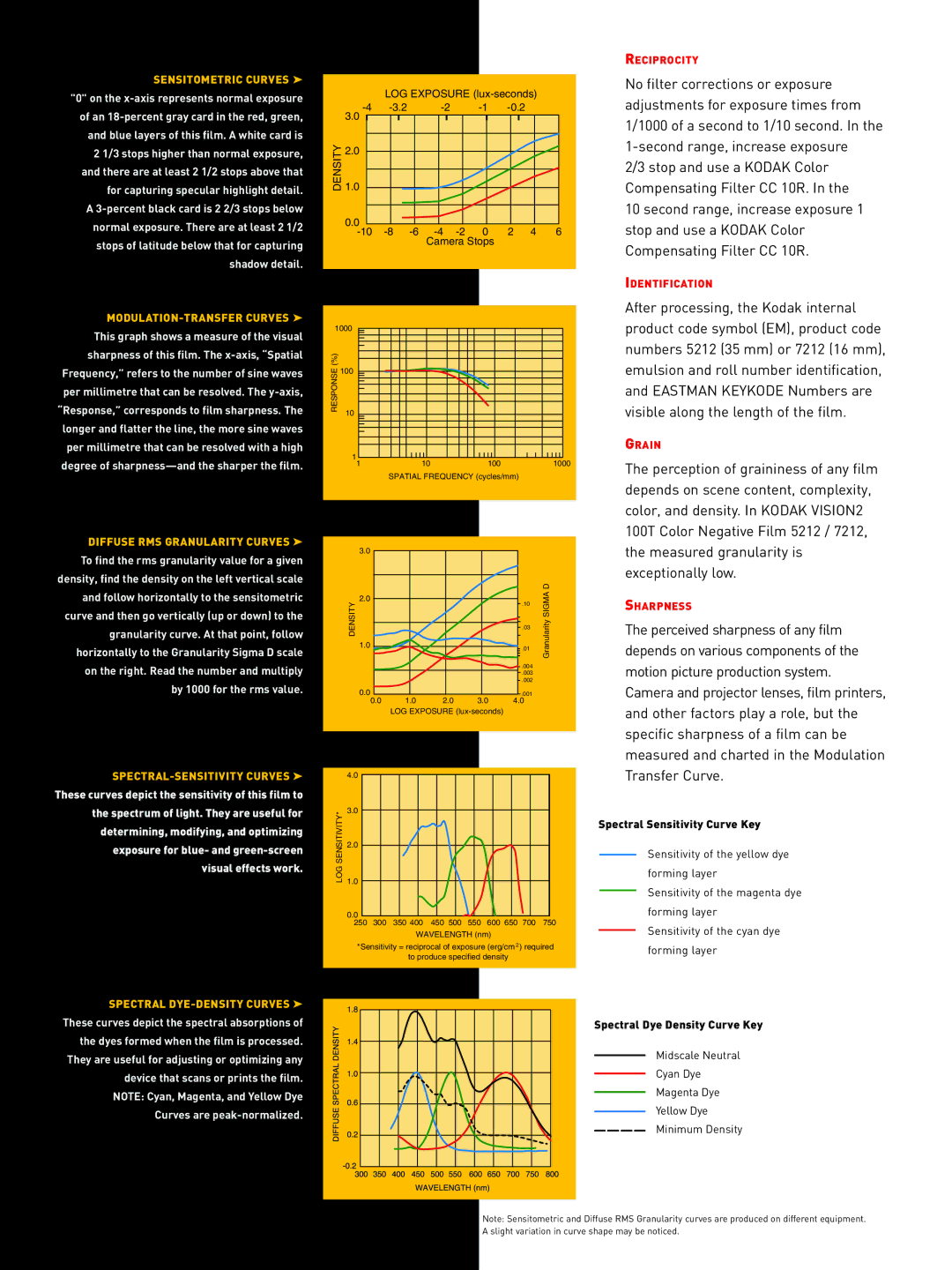
SENSITOMETRIC CURVES ➤
"0" on the
A
LOG EXPOSURE
|
| |||||
3.0 |
|
|
|
|
|
|
2.0 |
|
|
|
|
|
|
DENSITY 1.0 |
|
|
|
|
|
|
0.0 |
| 0 | 2 | 4 | 6 | |
|
| Camera Stops |
|
|
| |
RECIPROCITY
No filter corrections or exposure adjustments for exposure times from 1/1000 of a second to 1/10 second. In the
10 second range, increase exposure 1 stop and use a KODAK Color Compensating Filter CC 10R.
MODULATION-TRANSFER CURVES ➤
This graph shows a measure of the visual sharpness of this film. The
DIFFUSE RMS GRANULARITY CURVES ➤
To find the rms granularity value for a given density, find the density on the left vertical scale and follow horizontally to the sensitometric curve and then go vertically (up or down) to the granularity curve. At that point, follow horizontally to the Granularity Sigma D scale on the right. Read the number and multiply by 1000 for the rms value.
SPECTRAL-SENSITIVITY CURVES ➤
These curves depict the sensitivity of this film to the spectrum of light. They are useful for determining, modifying, and optimizing exposure for blue- and
SPECTRAL DYE-DENSITY CURVES ➤
These curves depict the spectral absorptions of the dyes formed when the film is processed.
They are useful for adjusting or optimizing any device that scans or prints the film.
NOTE: Cyan, Magenta, and Yellow Dye Curves are
|
| IDENTIFICATION |
|
| After processing, the Kodak internal |
1000 | product code symbol (EM), product code | |
(%) |
| numbers 5212 (35 mm) or 7212 (16 mm), |
| emulsion and roll number identification, | |
RESPONSE | 100 | |
| and EASTMAN KEYKODE Numbers are | |
|
| |
| 10 | visible along the length of the film. |
|
|
|
|
|
|
|
|
|
| GRAIN |
| 1 |
| 10 |
|
| 100 |
|
| 1000 |
|
| 1 |
|
|
|
|
| The perception of graininess of any film | |||
|
|
| SPATIAL FREQUENCY (cycles/mm) |
|
| |||||
|
|
|
|
| depends on scene content, complexity, | |||||
|
|
|
|
|
|
|
|
|
| |
|
|
|
|
|
|
|
|
|
| color, and density. In KODAK VISION2 |
|
|
|
|
|
|
|
|
|
| 100T Color Negative Film 5212 / 7212, |
| 3.0 |
|
|
|
|
|
|
|
| the measured granularity is |
|
|
|
|
|
|
|
|
|
| |
|
|
|
|
|
|
|
|
|
| exceptionally low. |
|
|
|
|
|
|
|
|
| D |
|
| 2.0 |
|
|
|
|
|
| .10 | GranularitySIGMA | SHARPNESS |
| DENSITY |
|
|
|
|
|
| |||
|
|
|
|
|
|
|
| |||
|
|
|
|
|
|
|
| depends on various components of the | ||
|
|
|
|
|
|
|
| .03 |
| The perceived sharpness of any film |
| 1.0 |
|
|
|
|
|
| .01 |
|
|
|
|
|
|
|
|
|
|
|
| |
|
|
|
|
|
|
|
| .004 |
| motion picture production system. |
|
|
|
|
|
|
|
| .003 |
| |
|
|
|
|
|
|
|
| .002 |
| Camera and projector lenses, film printers, |
| 0.0 | 0.0 | 1.0 | 2.0 | 3.0 |
| .001 |
| ||
|
| 4.0 |
| and other factors play a role, but the | ||||||
|
|
| LOG EXPOSURE |
|
|
| ||||
|
|
|
|
|
|
|
|
|
| specific sharpness of a film can be |
|
|
|
|
|
|
|
|
|
| measured and charted in the Modulation |
| 4.0 |
|
|
|
|
|
|
|
| Transfer Curve. |
SENSITIVITY* | 3.0 |
|
|
|
|
|
|
|
|
|
|
|
|
|
|
|
|
|
| Spectral Sensitivity Curve Key | |
| 2.0 |
|
|
|
|
|
|
|
| Sensitivity of the yellow dye |
LOG |
|
|
|
|
|
|
|
|
| |
1.0 |
|
|
|
|
|
|
|
| forming layer | |
|
|
|
|
|
|
|
|
| ||
|
|
|
|
|
|
|
|
| Sensitivity of the magenta dye | |
|
|
|
|
|
|
|
|
|
| |
| 0.0 |
|
|
|
|
|
|
|
| forming layer |
| 250 | 300 | 350 400 | 450 500 | 550 | 600 650 | 700 | 750 | Sensitivity of the cyan dye | |
|
|
| WAVELENGTH (nm) |
|
|
| ||||
| *Sensitivity = reciprocal of exposure (erg/cm 2) required | forming layer | ||||||||
|
|
| to produce specified density |
|
|
| ||||
|
|
|
|
|
|
| ||||
|
|
|
|
|
|
|
|
|
| Spectral Dye Density Curve Key |
|
|
|
|
|
|
|
|
|
| Midscale Neutral |
Cyan Dye
Magenta Dye
Yellow Dye
Minimum Density
Note: Sensitometric and Diffuse RMS Granularity curves are produced on different equipment.
A slight variation in curve shape may be noticed.
